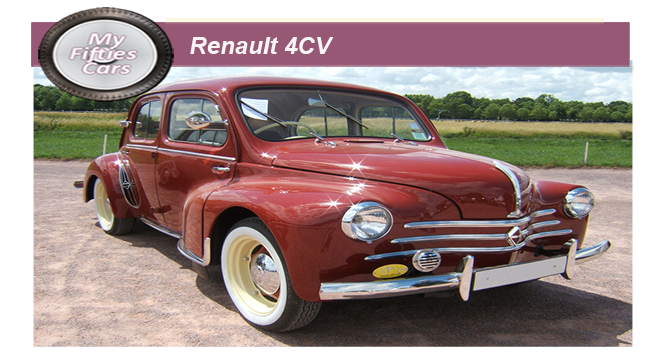
An item of obscure history, not very well-known, is that legendary father and son design team Ferdinand and "Ferry" Porsche were the brains behind the Renault 4CV.
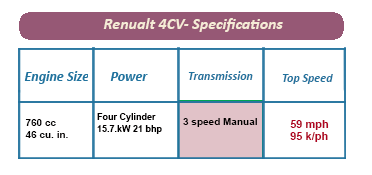 Taken into custody by the American occupation forces shortly after the end of World War Two and imprisoned by the French.
Taken into custody by the American occupation forces shortly after the end of World War Two and imprisoned by the French.
The Porsches, had gained a certain notoriety for being behind the pre-war design of the Volkswagen Beetle and the French Government, eager to get their domestic car production up and running after the war, took advantage of their “ guests “ combined talents to in the creation of their version of the " people's car" the Renault 4CV.
Ferry Porsche was released in 1946, although his father's services were " retained" for more than a year longer to allow him to wind up his design work.
The Renault 4CV was shown for the first time at the Paris motor show in October 1946, with most agreeing that the car bore more than a subtle resemblance to the early Beetle.
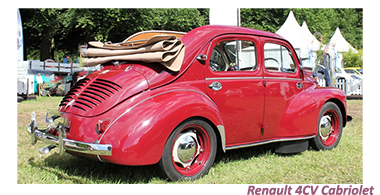 Once again, Porsche had displayed his almost unique gift in designing a " people car" for the post-war era.
Once again, Porsche had displayed his almost unique gift in designing a " people car" for the post-war era.
 While the 4CV could be regarded in modern times as a compact, it still allowed sufficient space for four adults to travel in relative comfort while being economical with fuel and providing an impressive turn of speed.
While the 4CV could be regarded in modern times as a compact, it still allowed sufficient space for four adults to travel in relative comfort while being economical with fuel and providing an impressive turn of speed.
Despite the pre-war economy in France and indeed all of Western Europe being still fragile, orders streamed in for the 4CV in unprecedented numbers.
![]()
Soon the waiting list for the car grew so long, that those entering it, did so in the knowledge that they would be waiting for their new 4CV for up to two years.
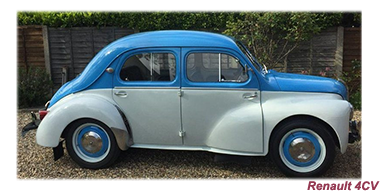 Those looking on in envy at the first 4CV cars may not have known how lucky they were not to get their hands on the first 4CVs that made it on to the highways of Europe.
Those looking on in envy at the first 4CV cars may not have known how lucky they were not to get their hands on the first 4CVs that made it on to the highways of Europe.
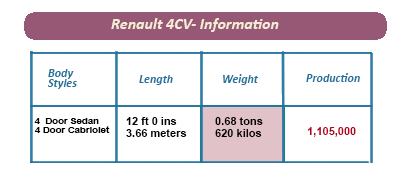 To begin with, they were not difficult to miss, as they were all sprayed with sand-yellow camouflage paint destined for trucks intended for the Afrika-Corps, Because of its distinctive colour; the early 4CV's were rapidly nicknamed 'La Motte de Guerre' meaning lump of butter.
To begin with, they were not difficult to miss, as they were all sprayed with sand-yellow camouflage paint destined for trucks intended for the Afrika-Corps, Because of its distinctive colour; the early 4CV's were rapidly nicknamed 'La Motte de Guerre' meaning lump of butter.
Apart from that possible setback, the 4CV could be challenging to operate, with a clumsy three-speed constant mesh gearbox,its notoriously irritating floor-mounted mixture control and underpowered 13kW (18bhp) engine.
With demand for the model seemingly unceasing, Renault established a policy and invested whatever resources at their disposal to continuously improve the 4CV to make the driving experience as pleasant as it could be in a basic economy car.
 Initially, the 4CV was only available as a four-seat sedan, powered by a rear-mounted four-cylinder engine, matched up to a three-speed gearbox
Initially, the 4CV was only available as a four-seat sedan, powered by a rear-mounted four-cylinder engine, matched up to a three-speed gearbox
The Renault 4CV was far from sleek in design but did have a certain "French" charm with its short front hood and sloping tail.
![]()
Six wide horizontal bars across its front panel gave the appearance of a grille, even though the engine was mounted in the back, beneath a louvred engine lid. 'Suicide" (rear-hinged) front doors were installed, while rear doors were hinged at the front.
The 4Cv's front doors had a distinct " bulge" to them to allow them to mate with front fenders.
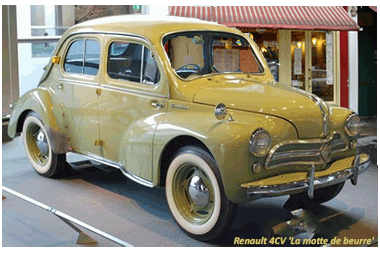 Production of the four-door sedan continued with little change throughout the Fifties, eventually offered with a sunroof, as well as "decal potable," with a full-length sunroof.
Production of the four-door sedan continued with little change throughout the Fifties, eventually offered with a sunroof, as well as "decal potable," with a full-length sunroof.
The 4CV was fitted with a 747cc (46 cu in) engine, to replace the original version's underachieving 760cc (46 cu in) unit while a Ferlec automatic clutch became an optional extra.
The car's dashboard contained an open glove box on the right, a hooded instrument cluster ahead of the driver, and a decorative panel in the centre that could accept a radio.
> Standard equipment included a heater, defroster, directional signals, and leatherette upholstery, new rubber-mounted front wheel suspension and an automatic choke, sun visors and interior door handles.
Standard equipment included a heater, defroster, directional signals, and leatherette upholstery, new rubber-mounted front wheel suspension and an automatic choke, sun visors and interior door handles.
Renault were convinced that with the introduction of the Dauphine in 1956, demand for the 4CV would soon taper out.
To their pleasant surprise, the market for the 4CV never faltered. Eventually they were ultimately forced to "retire" the car in late 1959, with sales having passed the million mark.

